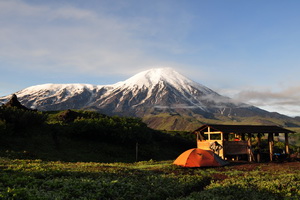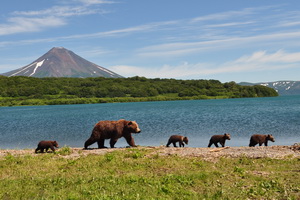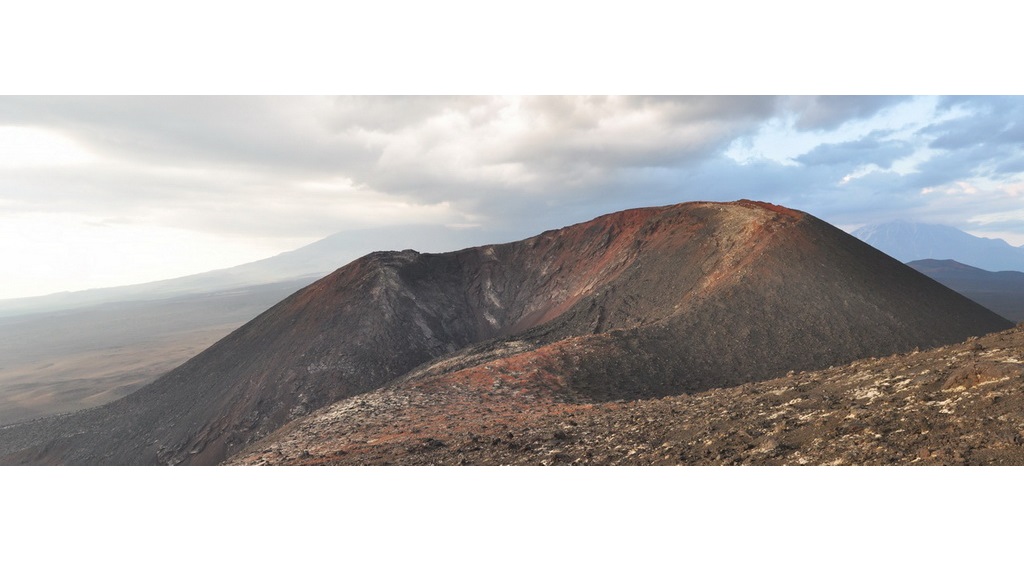Main / Sights
Great Tolbachik Fissure Eruption
From the top of the Tolbachik Volcano you can observe a good view of the south-western slope and numerous cinder cones, where the events of the famous Great Tolbachik Fissure Eruption occurred in 1975-76.
On July 6, 1975 in 18 kilometers from the central crater a crack opened with the length of about 600 meters and above it a wall of fire rose. Then it was divided into separate fountains of pyroclastic material, and cinder cones quickly began to form around. A few hours later there was only one crater - a crater Cone First, which was then called Gorshkov Cone.
The diameter of the crater was a few dozen meters. The jet of gas coame out of the crater with a velocity of 200-300 meters per second (or higher) and formed a candle up to 2 kilometers. The first large lava flow appeared on the 24th day of the eruption. On the morning of August 9, Cone First subsided after 35 days of activity.
After 12 hours, in 700 meters to the north the second crack formed, with the length of about 400 meters. Out of which the Cone Second grew up. It poured out lava from the date of its formation. The width of the lava flow from the cone was more than 1 kilometer, length - 5 km, thickness - 80-90 meters. On August 17, 1975 further to the north the Cone Third formed.
The First and Second cones were very large for basalt volcanoes. The height of their eruptions were 310 and 290 meters. As a result of sedimentation they then fell down for 10 meters. The height of the third cone – 108 meters, it has a dual crater.
Near the three cones 0.68 km³ of ash and slag fell down on the earth. Within the scopes of 100 kilometers from the volcano all the vegetation was covered with a thick layer of ash, which is toxic to many species of plants.
Later, the group was called the North Break (northern cones breakthrough). It was active for 72 days and the total amount of the eruptive products reached 1.26 km³. Its activity itself would be one of the biggest volcanic eruptions of the 20th century. However, it was only the first stage of the Great Tolbachik Fissure eruption.
On September 18, 1975 in 10 kilometers from the North eruption a new crack with the length of about 600 meters was formed. The eruption lasted more than 450 days, and it was named the South Break (southern breakthrough). In the crater there were 5-15 explosions or lava bursts per minute ejection height of about 200 meters. This activity is called "Strombolian". Cinder cones reached the altitude of 160 meters. Lava covered about 36 km3. The average thickness of the lava cover of the Southern breakthrough reached 30 meters and its volume - 0.97 km³.
The strength of the eruption of the Southern break gradually decreased by the end of 1976 and on the 10th of December, the eruption ended.
The active area of the Great Tolbachik Fissure eruption stretched for 28 kilometers from the volcano Flat Tolbachik to the Southern Cone breakthrough. Along it rose a chain of large cinder cones – New Tolbachik volcanoes. Around the Southern breakthrough a thick basalt lava cover formed. The lava had covered 45 km². The total volume of the eruption reached 2.3 km³.
Tours
 Trekking around the Tolbachik Volcano
The route of this tour runs through the territory of the Klyuchevskoy Nature Park that is included into the World Herita...
Trekking around the Tolbachik Volcano
The route of this tour runs through the territory of the Klyuchevskoy Nature Park that is included into the World Herita...
 Kurile Lake. Volcanoes Gorely, Avachinsky and Tolbachik
We would like to offer you tour to the extraordinary by its beauty Kuril Lake, where you are to watch the brown bear ...
Kurile Lake. Volcanoes Gorely, Avachinsky and Tolbachik
We would like to offer you tour to the extraordinary by its beauty Kuril Lake, where you are to watch the brown bear ...

